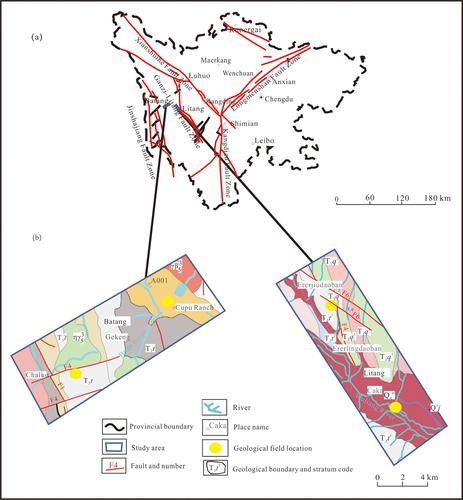当前位置:
X-MOL 学术
›
Acta Geol. Sinica Engl. Ed.
›
论文详情
Our official English website, www.x-mol.net, welcomes your
feedback! (Note: you will need to create a separate account there.)
Genesis of Geothermal Fluid in Typical Geothermal Fields in Western Sichuan, China
Acta Geologica Sinica-English Edition ( IF 3.5 ) Pub Date : 2021-03-30 , DOI: 10.1111/1755-6724.14715 Jiayi ZHAO 1 , Guiling WANG 1 , Cuiyun ZHANG 1 , Linxiao XING 1 , Man LI 1 , Wei ZHANG 1
Acta Geologica Sinica-English Edition ( IF 3.5 ) Pub Date : 2021-03-30 , DOI: 10.1111/1755-6724.14715 Jiayi ZHAO 1 , Guiling WANG 1 , Cuiyun ZHANG 1 , Linxiao XING 1 , Man LI 1 , Wei ZHANG 1
Affiliation

|
The hydrogeochemical characteristics of geothermal fluids can reveal the genesis of geothermal systems and act as important references for developing and using geothermal resources. This study presents hydrogeochemical processes and thermal cycle mechanisms of typical geothermal fields in Western Sichuan. Based on the geological conditions in Western Sichuan, 29 hot springs in three geothermal fields in the Batang and Litang areas were selected for hydrochemical and isotopic (δD and δ18O) analyses. Furthermore, the temperature of the thermal reservoir was calculated and the upflow cooling process of the hot springs was analyzed. Most of the subterranean hot waters in Batang and Litang are of the HCO3-Na hydrochemical type. The ion variation in Batang is primarily affected by water-rock interactions. There is a strong positive correlation between Na+, B−, and Cl− in Litang, suggesting that they have the same material source. The Na+ and metaboric acid content is relatively high, which indicates that the groundwater runoff in both areas is relatively long-lasting, with reduced flow velocity; moreover, the metasilicic acid content is relatively high, which supports this conclusion. Both hydrogen and oxygen isotopes plot near the atmospheric precipitation line, indicating that groundwater recharge is functionally obtained from precipitation. The calculated thermal storage temperatures in Batang and Litang were 88–199°C and 96–154°C, respectively. The proportion of cold water mixing in Batang was 64%–67%, while that in Litang was 60%–68%. According to the calculated results, the initial thermal cycle depth of the Batang area (4540–4780 m) was greater than that of the Litang area (3150–3960 m). The enthalpy of the deep parental geothermal fluid in Batang was 1550 J/g with a Cl− concentration of 37 mg/L, while that in Litang was 2100 J/g with a Cl− concentration of 48 mg/L.
中文翻译:

川西典型地热田地热流体成因
地热流体的水文地球化学特征可以揭示地热系统的成因,为开发和利用地热资源提供重要参考。本研究介绍了川西典型地热田的水文地球化学过程和热循环机制。基于川西地质条件,被选择用于在巴塘和理塘区域的三个地热田29个温泉水化学和同位素(δ d和δ 18 O)的分析。此外,计算了热库的温度,分析了温泉的上流冷却过程。巴塘和理塘的大部分地下热水是 HCO 3-Na 水化学类型。巴塘的离子变化主要受水岩相互作用的影响。理塘中Na +、B -和Cl -之间存在很强的正相关,表明它们具有相同的物质来源。钠+偏硼酸含量较高,说明两地地下水径流持续时间较长,流速降低;此外,偏硅酸含量相对较高,支持了这一结论。氢和氧同位素都绘制在大气降水线附近,表明地下水补给在功能上是从降水中获得的。计算出的巴塘和理塘蓄热温度分别为 88-199°C 和 96-154°C。巴塘冷水混合比例为64%~67%,理塘为60%~68%。根据计算结果,巴塘地区的初始热循环深度(4540-4780 m)大于理塘地区(3150-3960 m)。巴塘深层母体地热流体的焓为 1550 J/g,Cl−浓度为 37 mg/L,而在理塘为 2100 J/g,Cl -浓度为 48 mg/L。
更新日期:2021-03-30
中文翻译:

川西典型地热田地热流体成因
地热流体的水文地球化学特征可以揭示地热系统的成因,为开发和利用地热资源提供重要参考。本研究介绍了川西典型地热田的水文地球化学过程和热循环机制。基于川西地质条件,被选择用于在巴塘和理塘区域的三个地热田29个温泉水化学和同位素(δ d和δ 18 O)的分析。此外,计算了热库的温度,分析了温泉的上流冷却过程。巴塘和理塘的大部分地下热水是 HCO 3-Na 水化学类型。巴塘的离子变化主要受水岩相互作用的影响。理塘中Na +、B -和Cl -之间存在很强的正相关,表明它们具有相同的物质来源。钠+偏硼酸含量较高,说明两地地下水径流持续时间较长,流速降低;此外,偏硅酸含量相对较高,支持了这一结论。氢和氧同位素都绘制在大气降水线附近,表明地下水补给在功能上是从降水中获得的。计算出的巴塘和理塘蓄热温度分别为 88-199°C 和 96-154°C。巴塘冷水混合比例为64%~67%,理塘为60%~68%。根据计算结果,巴塘地区的初始热循环深度(4540-4780 m)大于理塘地区(3150-3960 m)。巴塘深层母体地热流体的焓为 1550 J/g,Cl−浓度为 37 mg/L,而在理塘为 2100 J/g,Cl -浓度为 48 mg/L。











































 京公网安备 11010802027423号
京公网安备 11010802027423号